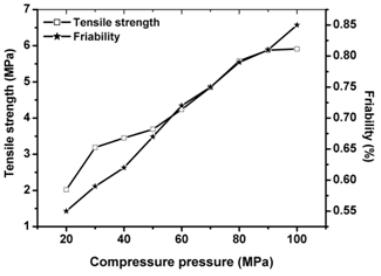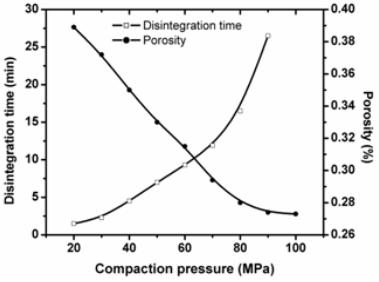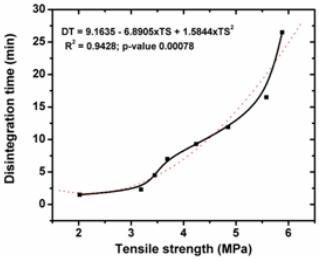Mi SciELO
Servicios Personalizados
Articulo
Indicadores
-
 Citado por SciELO
Citado por SciELO
Links relacionados
-
 Similares en
SciELO
Similares en
SciELO
Compartir
Tecnología Química
versión On-line ISSN 2224-6185
RTQ vol.31 no.2 Santiago de Cuba may.-ago. 2011
ARTÍCULO ORIGINAL
PHYSICOMECHANICAL AND COMPACTION CHARACTERIZATION OF TABLETS OBTAINED FROM A NATURAL DRY EXTRACTS
CARACTERIZACIÓN FISICO-MECÁNICA Y COMPACTATIVA DE COMPRIMIDOS OBTENIDOS DE EXTRACTOS SECOS NATURALES
MSc. Jesús Rafael Rodríguez-Amado, MSc. Ariadna LafourcadePrada, MSc. Julio Cesar Escalona-Arranz, MSc. Renato Pérez- Rosés, Phd. Antonio Iraizoz-Colarte
Department of Pharmacy, University of Orient, Santiago of Cuba. jimmy@cnt.uo.edu.cu
RESUMEN
En este trabajo se evaluó la influencia de la presión de compresión en las propiedades físico mecánicas de un comprimido obtenido a partir de un extracto seco de las hojas de Tamarindus indica L. El análisis de Heckel sugiere, que el extracto seco posee un mecanismo de deformación mixto con una Py igual a 179,85 MPa. La fuerza de torsión de los comprimidos aumenta con la presión de compactación. Los comprimidos deberán prepararse a presiones de compresión por debajo de 90 MPa ya que a presiones superiores el tiempo de desintegración aumenta sobre 30 min. La friabilidad de las tabletas nunca es superior del 1 %.
Palabras clave: tamarindo, extracto seco, análisis de Heckel, tabletas, compresión.
ABSTRACT
The aim of this work was to evaluate the compaction behavior and the physical mechanical characterization of tablets, obtained from a natural dry extracts of the leaves of Tamarindus indica L. The Heckel analysis was used to characterize the dry extract compaction behavior. The dry extract has a mixed mechanism of consolidation: plastic and brittle fracture, showing a mean yield pressure of 179,85 MPa. The compact’s tensile strength increase with the augment of compaction pressure. Compacts must be obtained at compaction pressure below 90MPa because of; at superior compaction pressure disintegration time increases over 30 min. The friability of the tablets in any case is superior to 1 percent.
Keywords: tamarind, dry extract, Heckel analysis, compression, tablets.
INTRODUCTION
The development of drugs obtained from natural products is a necessity in the whole world because it has multiple advantages for the patients. Around the world, a lot of medicinal plants are used to elaborate medicinal preparations, for that reason Tamarindus indica L is one of the most useful medicinal plant used by the population and it is used in liver disorders treatment in El Caribe [1].
Tamarindus indica L. (TIL) or Tamarind as commonly known, belonging to Fabaceae family, subfamily Caessalpinaceae is rich in fatty acids from 8 to 33 of carbon atoms, heavy alcohols like ß-sitosterol and cycloartanol; contain high levels of crude protein and essential aminoacids, and high contents of carbohydrate; rich in minerals as potassium, magnesium, phosphorus, copper, selenium, and calcium [2], reach in volatile oils [3].
Steroids, resins, mucilage and sugars are reporting for this species, too [4]. Dry extracts of natural products have many advantages compared to the liquids extracts, because of they are more stable, easy to handle and dose. However, natural dry extracts generally show deficient physical mechanical properties, bad compressing behavior and they are very sensitive to the moisture, that impede the direct compression [5].
The aim of this work was to evaluate the compaction behavior of a tablets obtaining from tamarind dry extracts, and the characterization of the variability of the physical mechanical properties of it with the augment of the compaction pressure applied.
THEORETICAL FOUNDATION
Dry extracts constitute the most important form of natural products in Pharmaceutical Industry, because they have a great chemical, physical, mechanical and pharmaceutical stability, since they possess very little humidity that is their main enemy. Pharmaceutical compacts, constitute the most important pharmaceutical form prepared with the dry extracts because of, not necessarily has to use water in the preparation and the dry extract can be protected, assurance they stability in the final formulation.
The physical mechanical properties of the dry extracts can be tested, to ensure they quality as row material for pharmaceutical formulation, and to provide enough information for the manufacture process on industry and for the subsequent compressed process on tableting machine, in this way the knowledge of the compaction behavior, as well as the variability o the some physical mechanical properties with the application of different compaction pressure has great relevance for the pharmaceutical technologist.
Heckel analysis [6] relate the compaction pressure with the material deformation behavior of it. It is based on the assumption that powder compression follows first-order kinetics, with the inter particulate pores as the reactant and the densification of the powder bed as the product.
Heckel analysis is expressed as:
ln(1/(1-D)) = KP + A (1)
Where D is the relative density of a powder compact at pressure P. Constant k is a measure of the plasticity of a com-pressed material. Constant A is related to the die filling and particle rearrangement before deformation and bonding of the discrete particles. Thus, a Heckel plot allows for the interpretation of the mechanism of bonding.
MATERIALS AND METHODS
Dry extract preparation
Tamarind dry extract (TDE) was prepared as follows: selected amounts of lactose monohydrate (Contero Excipients, Nueva Zeeland) and colloidal sillicon dioxide (Aerosil® V-200, Degusa, Belgium), were weighed and placed in a mortar, they were mixed carefully and passed through a sieve of 250um. An equivalent amount of 30g as total solids of the tamarind soft extract (TSE) was added; this mixture was thoroughly manually blended until an adequate consistency was achieved and was then strained through a sieve with a nominal aperture of 250um and dried in a vacuum stove (MLW, Germany) at 40 ± 2 ºC for three hours. Dry extract was cooled at room temperature on desiccators and grinded in a mortar until the mass powder passed through a sieve with a nominal aperture of 250 um. [7]
Tablets preparation
In the preparation of TDE tablets, 5 % of polyvinylpyrrolidone (Kolidón 25, Basf Germany) as binder, and 4% of croscarmellose sodium (CCS) (Ad-Di-Sol, Blanver Brazil) as disintegrant were added, and manually thoroughly mixed in a mortar for 5 minutes. Tablets were compressed in a PerkinElmer (Cambridge, UK) hydraulic press using 12.5mm-diameter biplane punches. The die and punches were lubricated atomizing over them, after each compression, a 1% solution of magnesium stearate (Derive SA, Germany) in ethanol. For each compact, 600 mg of powder was weighed on an analytical balance (Digital Balance, Sartorius, Germany), and then manually filled into the die.
Physical mechanical properties of the tablets
Tensile strength
Diametrical crushing strength (CS) of tablets was evaluated using an Eureka strength tester (TBH-28, GmbH, Offenbach, Germany), tablets diameter (d) and height (h) expressed in cm were measured using a screw gauge micrometer capable of differentiating up to 0.01mm. Tensile strength (TS) of the tablets was computed from Fell & Newton expression:
TS = 2 x CS / p x h x d (2)
Disintegration time
Disintegration time was measured according to the literature, in a disintegration tester (Eureka, Germany). 900ml of water at 37 ± 2 °C were used as test medium. For each formulation, 6 tablets selected randomly were tested.
Friability
Tablet friability (Fr) was measured as the percentage of weight loss of 20 tablets tumbled in a Roche friabilator following USP 30 specification.
Heckel analysis
The Heckel analysis (equation 1) was made using tablets prepared at compaction pressure (CP) between 20 and 100MPa, in a hydraulic press (mentioned above) using 12,5 mm flat faces punches. [6] At every pressure applied, the diameter, height, and weight of the tablets were measured. The density (D) at every pressure was divided by the real density measured in a helium picnometer (QuantaCrome Foran, USA) and relative density (D) was calculated.
Where D is the relative density of the compact at pressure P, K is the slope of the linear portion of the plot, and A is a function of the initial bulk volume (intercept on a Heckel plot). Constant A is related to the die filling and particle rearrangement at nil pressure.
The slope (K) of the Heckel equation provides information about the compaction mechanism of a substance [6] and can be correlated with the Young´s module. K and A were calculated [8] fitting data to a linear function using Origin® 6.1 (v6.1052 (B232), Northampton, MA, USA). Mean yield pressure (Py) was calculated as the inverse of the slope (1/K) expressed in MPa.
Porosity
The porosity (e) of the compacts at pressure P was also computed using Heckel parameters as:
- ln ε= ln (1/ (1-D)) (3)
Statistical analysis
All assays were made by quintuplicate, and the mean and standard deviation were reported. Statistical analysis was made using StatGraphics
Plus 5.0. Stat Ease Co. Minneapolis, USA.
RESULTS AND DISCUSSION
Physical mechanical properties of the tablets
The mean and standard deviation of the tablets´ properties are listed in table.
Table
Mechanical properties of the tablets
prepared at different compaction pressure. (n = 5)

Analysis of the Heckel plot
Heckel’s analysis has been used to classify powders as their compaction behavior and for the interpretation of the mechanism of bonding. Mean yield pressure (Py) is the pressure required to deform a powder or granules and to obtain compacts, and is defined as the inverse of slope of the linear portion of the Heckel plot [6,8]. The slope (K) is an indication of the deformation behavior of the material. With increasing slope of the Heckel´s plot (low values of Py), the amount of plastic deformation increases, i.e. microcystalline celulose (Avicel) has a Py equal to 54Mpa; when K is decreased (high values of Py) is an indication of the material compressing behavior is mainly fragmentation, i.e. dibasic dicalcium phosphate (Emcompress) has a Py equal to 250MPa [9]. A low Py value, however need not necessarily reflect that the compact has an acceptable tensile strength [10]. The value of slope (K= 0,005 56) obtained from the linear portion (from 20 to 80 MPa, R2 = 0,999 1) of the Heckel graph (Figure 1) corresponds to the apparent value of mean yield pressure (Py) of 179,85 MPa, this results suggest a mix deformation behavior for TDE.
Fig. 1 Heckel´s plot for tamarind dry extract. Tensile strength and friability
Tensile strength augments as the compression pressure increases (figure 2). This behavior is in accordance with many authors that describe the same behavior for tablets prepared with natural extracts. [11,13]
Fig. 2 Tensile strength and friability versus compaction pressure.
A linear relationship between TS and CP was found. The adjusted model for this relation (equation 4) exhibit a R2 equal to 0,982 9 with statistical significance (p-value of 0,000 1) for 95 % of confidence. (Data not reported)
TS = 1,407 22 + 0,048 42 x CP (4)
In this work, soft tablets were obtained. According to literatures, lactose monohydrate (48 % of the dry extract composition) usually produces soft compacts because its fragmentation behavior of compaction creates a large number of small particles, that’s why the number of contact points that support the applied load is large, so that the stress on each contact point is relatively small. The strength of bonds formed in compacts will therefore be relatively low [11, 12 y 13].
In the same way, as the TS augments the Fr increase but in no case over one per cent; this behavior was observed by other authors’ [11]. The fitted model (equation 5) for this relationship explains the 98,94 % (R2 = 0,989 4, p-value 0,000 1) of the variability of Fr as function of TS with 95 % of confidence.
Fr = 0,401 11 + 0,004 33 x TS (5)
Disintegration time and porosity
The DT in tablet formulations are influenced by many factors like, hardness, porosity, the amount of disintegrant, the disintegration mechanisms (i.e. swelling or capillary forces), the amount of lubricant and compression force [16].
Fig. 3 Behavior of the disintegration related to the compaction pressure and the porosity.
The relationship between compression pressure versus Porosity and DT is showed in figure 3. As compaction pressure increases the porosity of tablets decrease and DT increases, this fact is reported on literature [11]. It must be noted that, DT for a compaction pressure over 90MPa and further, tablets do not disintegrate, being this value critical because beyond this point the DT observed is at limits established for not coating tables (30 min.) It is possible that at these values of CP the porosity of the tablets be too low, preventing the water penetration and the swelling ability of the disintegrant agent be impede.
As it is showed in the graphic (figure 3), the lower CP the higher the porosity of tablets. DT is minor as the CP applied decreases and is reduced significantly at higher porosity of the tablets (lower CP), due to that more porosity facilitates the water penetration and swelling of CCS and tablets can disintegrate more quickly.
The experiment showed that values of CP between 70 to 80 MPa, the DT of the tablets is between 11,9 and 16,5 min., due to this fact a further work on the formulation studies of tablet using TDE is currently being performed by our research group to minimize the disintegration time optimizing the amount and kind of disintegrant.
Fig. 4 Disintegration time versus tensile strength for tamarind dry extract tablets. Polynomial fitted appears in dotted line.
The augment of TS increases the DT of the tablets (figure 4). It’s possible that compaction pressure over 90MPa causes an interaction between binder (PVP) and the component of the extracts even with the CCS forming a very rigid network, tablets became harder and disintegration never occurs. A good second order polynomial model that can describe 94,28 % of the DT variability as a function of TS was found with 95 % of confidence.
The expression and some statistical parameters for this relationship are showed in figure 4.
CONCLUSIONS
The dry extract has a mixed mechanism of consolidation: plastic and brittle fracture, showing a mean yield pressure of 179,85 MPa. The tensile strength of the compacts increase with the compaction pressure applied fallowing a straightforward relationship. Compacts must be obtained at compaction pressure below 90M Pa because of; at superior compaction pressure disintegration time increases over 30 min. The friability of the tablets in any case was superior to 1 percent.
BIBLIOGRAPHY
1. ACES, RP. Plantas útiles de las antillas. Editora Científico Técnica. La Habana. 1979.
2. SAMINA KK, SHAIKH W, SHAHZADI S, KAZI TG, USMANGHANI K, KABIR A, SHEERAZI TH. Chemical constituents of Tamarindus indica L. medicinal plant in sindh. Pak. J. Bot. 40. 2008. Págs. 2553-2559.
3. PINO JA, ESCALONA JC, LICEA I, PEREZ RR, AGUERO J. Leaf oil of Tamarindus indica L. JEOR. 14: 2002. Págs. 187-188.
4. EL-SIDDIG G, PRASAD P, RAMANA VW. Tamarind, Tamarindus indica. Southampton Centre for Underutilised Crops, Southampton, UK. 2006
5. DE SOUZA TP, GÓMEZ TJ, MARTÍNEZ R, PETROVICK RP. Compression behavior of formulations from Phyllanthus niruri spray dried extract. Pharmazie. 61: 2006. Págs. 213-217.
6. HECKEL WR. An analysis of the powder compaction phenomena. Trans Metallurg Soc AIME., 221: 1961. Págs. 1001-1008.
7. RODRÍGUEZ AJ. Obtención y caracterización de un Nuevo extracto vegetal para compresión directa. Disertación. IFAL-UH. 2009.
8. LANDÍN M, MARTÍNEZ R, GÓMEZ LJ. The effect of country of origin on the properties of dicalcium phosphate dihydrate powder. Int J Pharm., 103: 1994. Págs. 9-18.
9. ISIMI YC. Effects of the diluent type on the compressional characteristics of the mixed stem bark extract of Anogeissus leiocarpus and Prosopis africana tablet formulation, Acta Pharm. 2003; 53: Págs. 49-56.
10. VAN DER VOORT KM, BOLHUIS KG. Improving properties of materials for direct compression. Pharm Technol Europe., 10: 1998. Págs. 30-35.
11. VAN DER VOORT KM, BOLHUIS KG. Bolhuis, Improving properties of materials for direct compression. Pharm Technol Europe., 10: 1998. Págs. 28-36.
12. COLE TE, REES EJ, HERSEY AJ. Relations between compaction data for some crystalline pharmaceutical materials. Pharm Acta Helv., 50: 1975. Págs. 28-32.
13. SHANGRAW R, Mitrevej R, Shah AM. New era of tablet disintegrant. Pharm Technol., 4: 1980. Págs. 49-57.
Recibido: Septiembre de 2010
Aprobado: Abril de 2011
MSc. Jesús Rafael Rodríguez-Amado. Department of Pharmacy, University of Orient, Santiago of Cuba. jimmy@cnt.uo.edu.cu


















